Recent Water Damage Posts
The Aftermath of Water Damage: Handling Mold and Mildew Like a Pro with SERVPRO®
3/12/2025 (Permalink)
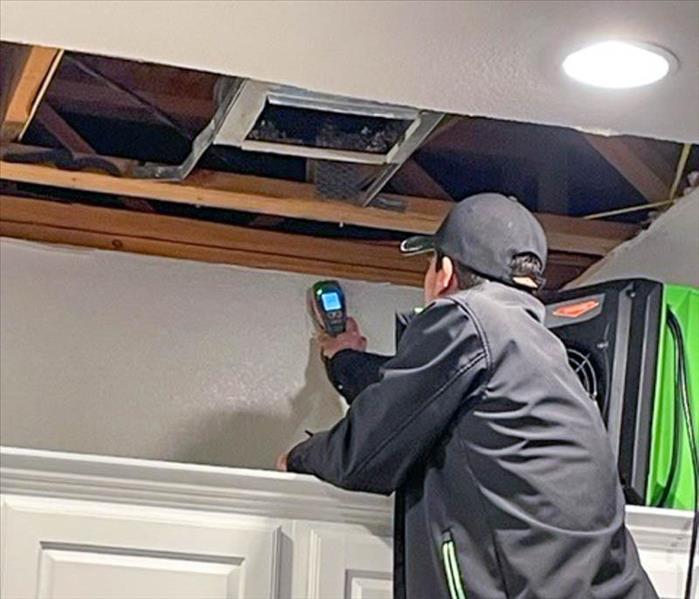 Water damage is never just about the initial flooding or leaks—it’s also about what comes after.
Water damage is never just about the initial flooding or leaks—it’s also about what comes after.
Water damage is never just about the initial flooding or leaks—it’s also about what comes after. One of the biggest concerns following water damage is the rapid growth of mold and mildew. These unwelcome guests can take hold in as little as 24 to 48 hours after water exposure, making swift action critical.
At SERVPRO®, we understand how overwhelming it can be to deal with water damage and its aftermath. That’s why we’ve put together this expert guide on how to handle mold and mildew after water damage, so you can protect your home, belongings, and structure effectively.
Why Mold and Mildew Are a Concern After Water Damage
Mold and mildew thrive in damp environments, and water damage provides the perfect conditions for growth. When moisture lingers in walls, floors, carpets, and even furniture, mold spores can settle in and begin spreading. If left untreated, mold can affect structural materials, causing deterioration over time.
Common Causes of Mold and Mildew Growth After Water Damage
- Lingering Moisture – Even after visible water is removed, high humidity and trapped moisture can promote mold growth.
- Porous Materials – Drywall, wood, insulation, and carpets absorb water quickly, creating an ideal environment for mold and mildew.
- Poor Ventilation – Without proper airflow, moisture remains trapped in affected areas, allowing mold to spread faster.
- Delayed Cleanup – The longer water-damaged areas remain untreated, the greater the risk of mold development.
How to Handle Mold and Mildew After Water Damage
The key to stopping mold and mildew in their tracks is quick and thorough action. Follow these steps to ensure effective cleanup and prevention.
1. Remove Excess Water Immediately
Start by extracting standing water as soon as possible. Use a wet/dry vacuum, mops, or towels to soak up excess moisture. The longer the water sits, the more likely mold will take hold.
2. Dry Affected Areas Thoroughly
Drying is one of the most crucial steps in preventing mold growth. Here’s how to do it effectively:
- Use air movers and fans to increase airflow in the affected areas.
- Set up dehumidifiers to pull moisture out of the air and surrounding materials.
- Open windows and doors (if weather permits) to improve ventilation.
- Remove damp items like rugs, upholstery, and curtains for separate drying or disposal if necessary.
3. Inspect for Mold Growth
Once the area has dried, check for signs of mold and mildew. Look for:
- Discoloration on walls, ceilings, and flooring
- A musty or damp odor
- Warping or peeling paint and wallpaper
If you notice any of these signs, deeper remediation may be required.
4. Clean and Disinfect Affected Surfaces
Even if mold isn’t visible, it’s best to treat water-damaged areas with a professional-grade cleaning solution to prevent spores from spreading. SERVPRO uses industry-approved cleaning and sanitizing methods to ensure thorough remediation.
5. Remove and Replace Severely Damaged Materials
Some materials may be too damaged to salvage, such as soaked drywall, insulation, or carpeting. In these cases, replacing them is the best way to prevent future mold issues.
6. Address the Source of Water Damage
To prevent mold from returning, identify and fix the root cause of the water damage. This may include:
- Repairing leaks in plumbing or appliances
- Sealing cracks in the foundation or walls
- Improving drainage around the property
- Inspecting and maintaining roofing and gutters
7. Call SERVPRO for Professional Restoration
While DIY cleanup is possible for minor water damage, severe or widespread issues require professional expertise. SERVPRO specializes in water damage restoration, mold prevention, and remediation, ensuring your property is thoroughly dried and treated.
FAQs: Handling Mold and Mildew After Water Damage
Q: How long does it take for mold to grow after water damage?
A: Mold can start growing within 24 to 48 hours after water exposure, making fast action essential.
Q: Can I clean mold myself, or do I need professional help?
A: Small, surface-level mold spots can sometimes be cleaned with the right techniques. However, widespread mold or moisture trapped in walls, flooring, and ceilings should be handled by SERVPRO professionals to ensure complete removal.
Q: Will running a dehumidifier prevent mold after water damage?
A: Yes, using a dehumidifier helps reduce moisture levels, making it harder for mold to grow. However, it should be used in combination with proper drying techniques and inspections.
Q: What materials are most susceptible to mold growth after water damage?
A: Porous materials like drywall, wood, insulation, carpeting, and upholstery are highly vulnerable to mold growth.
Q: How does SERVPRO help with mold prevention after water damage?
A: SERVPRO provides complete water damage restoration services, including advanced drying methods, moisture detection, and mold prevention solutions to ensure your home or business is fully restored.
Let SERVPRO Handle Your Water Damage and Mold Concerns
Dealing with water damage is stressful, and the last thing you need is mold complicates the restoration process. At SERVPRO, we have the experience, tools, and techniques to handle water damage effectively and prevent mold growth before it becomes a bigger issue.
If you’re facing water damage and want to ensure your home is properly dried and restored, contact SERVPRO today. Our experts are ready to help, providing fast and reliable service to get your property back to normal.
Is Your Home at Risk? How High Humidity Can Lead to Expensive Water Damage
9/18/2024 (Permalink)
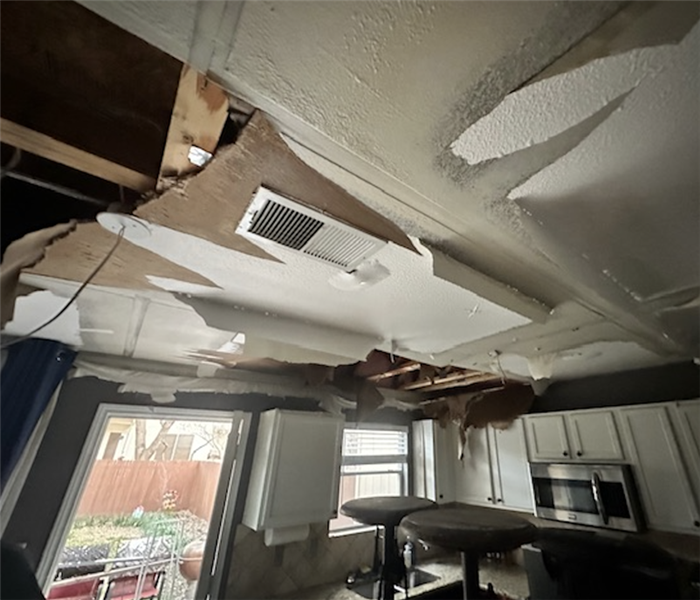 High humidity might seem like just another part of life in San Antonio, but it can seriously damage your home if you’re not careful.
High humidity might seem like just another part of life in San Antonio, but it can seriously damage your home if you’re not careful.
If you live in San Antonio, TX, you know how sticky and uncomfortable high humidity can be. But did you know that it could be doing more than just making you sweat? High humidity can silently wreak havoc on your home, leading to serious water damage that can cost you big bucks. Let’s take a closer look at how high humidity can affect your home and what you can do to protect it.
The Sneaky Dangers of High Humidity
Humidity might seem like just another part of life in Texas, but when it’s consistently high, it can cause some real problems in your home. When the air is packed with moisture, it has a way of creeping into every corner, leading to condensation—and eventually, water damage.
How Humidity Turns into Water Damage
When warm, humid air hits cooler surfaces like your windows, walls, or pipes, condensation forms. Over time, this moisture can seep into walls and floors, causing them to weaken and break down. What starts as a little damp spot can turn into a big, expensive repair job.
Humidity and Mold: A Dangerous Duo
One of the worst things about high humidity is how it encourages mold growth. Mold loves damp, warm places, and if your home’s humidity is out of control, mold can take hold fast. Mold isn’t just gross—it can be expensive to deal with.
Structural Damage: The Hidden Threat
High humidity doesn’t just stop at surface problems—it can dig deep, affecting the very structure of your home. When wood, drywall, and even your foundation soak up moisture from the air, they can swell, warp, and eventually fall apart.
The Long-Term Financial Impact
If your home’s foundation starts to fail because of prolonged exposure to high humidity, you could be facing repair costs that climb into the tens of thousands. Keeping your home in good shape means keeping an eye on humidity levels.
How to Protect Your Home from High Humidity
The good news? You can take steps to keep humidity in check and protect your home from the damage it can cause. With a few simple changes, you can prevent high humidity from becoming a costly problem.
Use Dehumidifiers and Improve Ventilation
Dehumidifiers are your first line of defense, especially in moisture-prone areas like basements and bathrooms. Also, make sure your home is well-ventilated, particularly in places like the kitchen and laundry room where moisture tends to build up.
Stay on Top of Home Maintenance
Regularly check your home for signs of moisture, like condensation on windows or damp patches on walls. Catching these early can save you from bigger headaches down the road. Also, keep your gutters and downspouts clear to direct water away from your home.
Call in the Pros When Needed
If you suspect your home has water damage because of high humidity, don’t wait to get help. Professional water damage restoration services, like those offered by SERVPRO®, can step in to stop the damage and prevent it from getting worse.
Protect Your Home from High Humidity
High humidity might seem like just another part of life in San Antonio, but it can seriously damage your home if you’re not careful. By managing humidity levels and staying on top of maintenance, you can protect your home from expensive repairs. And if you ever find yourself dealing with water damage, SERVPRO of Northwest San Antonio is here to help get your home back in shape.
Water Damage Preparedness for Home-Based Businesses
6/10/2024 (Permalink)
Running a home-based business can be a rewarding experience, offering flexibility and convenience. However, as a home-based entrepreneur, it's crucial to prepare for potential risks, including water damage. Water-related issues can disrupt your business operations and cause financial losses. In this blog, we’ll cover strategies to help you protect your home-based business from water damage and minimize its impact on your work.
1. Assess Water Damage Risks
The first step in water damage preparedness is identifying the risks specific to your business and home. Common risks include plumbing leaks, flooding, burst pipes, and appliance malfunctions. Assess your workspace for vulnerabilities and address them as needed.
2. Have a Water Damage Response Plan
Create a water damage response plan that outlines how you will handle various scenarios. Include steps such as turning off water and electricity supplies, relocating essential equipment, and contacting restoration services. Practice your plan regularly so you know exactly what to do in an emergency.
3. Protect Equipment and Documents
Your business equipment and important documents are valuable assets. Store these items off the ground and in waterproof containers when possible. Consider investing in a water-resistant safe for critical files and backup important data digitally in a secure cloud-based service.
4. Install Water Detection Devices
Water detection devices can alert you to leaks or flooding early, allowing you to take action before the damage worsens. Place these devices in areas prone to water damage, such as basements, laundry rooms, or near appliances.
5. Maintain Your Home's Plumbing and Drainage Systems
Regular maintenance of your home's plumbing and drainage systems can help prevent leaks and water backup. Inspect pipes and drains for signs of wear and tear and address any issues promptly. Regularly clean gutters and downspouts to prevent water from pooling near your home.
6. Keep Emergency Supplies Handy
Prepare an emergency kit with essentials such as flashlights, a first aid kit, batteries, and a supply of water and non-perishable food. In the event of severe water damage, you may need to evacuate your home temporarily, and these supplies will come in handy.
7. Review Your Insurance Coverage
Ensure your homeowner's insurance policy includes coverage for water damage related to plumbing issues, flooding, or other water-related incidents. If necessary, consider adding additional coverage to protect your home-based business assets.
8. Secure Business Disruptions Coverage
In addition to insurance for property damage, look into business interruption insurance. This type of coverage can help replace lost income if your business operations are interrupted due to water damage or other covered events.
9. Keep Clients and Employees Informed
Communicate with your clients and employees about your water damage preparedness plan. Let them know how you will handle business disruptions and what to expect if a water-related emergency occurs. This will help maintain trust and minimize confusion during challenging times.
Stay informed about local weather forecasts, especially during storm seasons. Knowing what to expect can help you take proactive measures to protect your business from potential water damage. By following these preparedness strategies, you can safeguard your home-based business from the effects of water damage. Taking preventive measures and having a plan in place will help you navigate potential emergencies and minimize disruptions to your business operations.
Safeguarding Your Home: How Smart Home Technology Prevents and Monitors Water Damage
2/18/2024 (Permalink)
Water damage can cause significant harm to our homes and possessions. However, with the advent of smart home technology, we now have innovative tools at our fingertips to monitor and prevent water damage more effectively. In this blog post, we will explore how smart home technology is revolutionizing water damage monitoring and prevention.
Smart Water Leak Detectors
Smart water leak detectors are devices that can detect the presence of water in areas prone to water damage, such as basements, laundry rooms, or under sinks. These detectors can send immediate notifications to your smartphone or smart home hub, alerting you to potential leaks or flooding. By promptly identifying water issues, you can take immediate action to prevent extensive damage.
Remote Shut-Off Valves
Smart home technology enables the installation of remote shut-off valves for your water supply. With a few taps on your smartphone or through voice commands to your virtual assistant, you can remotely shut off the water supply in case of a leak or other water-related emergencies. This quick response can significantly reduce the potential damage caused by water leaks.
Moisture Sensors and Flood Alarms
Moisture sensors and flood alarms are smart devices that can detect abnormal levels of moisture in specific areas of your home. Placed near appliances, pipes, or in areas prone to leaks, these sensors can detect even the slightest increase in moisture and trigger alarms or push notifications to your devices. This allows for quick intervention before the water damage escalates.
Smart Irrigation Systems
Smart irrigation systems utilize weather data and soil moisture sensors to optimize watering schedules for your lawn and garden. By preventing overwatering or irrigation system malfunctions, these systems can minimize the risk of water damage to your landscape and the surrounding property.
Integration and Automation
One of the advantages of smart home technology is the ability to integrate various devices and automate actions. For example, you can set up rules so that if a water leak is detected, the smart home hub can automatically shut off the water supply, send notifications to your smartphone, and activate cameras to record the affected area. This integration and automation enable a seamless response to potential water damage incidents.
Real-Time Monitoring and Data Analytics
Smart home technology offers real-time monitoring and data analytics for water usage patterns. By tracking water consumption, you can identify irregularities that may indicate leaks, inefficient plumbing, or water-wasting behaviors. This information allows you to take proactive steps to address the root causes and prevent water damage.
Remote Access and Control
With smart home technology, you can access and control various water-related devices remotely. Whether you are at home, at work, or on vacation, you can monitor and control water-related devices, such as valves or irrigation systems, through smartphone apps or web interfaces. This remote access empowers homeowners to take immediate action to mitigate potential water damage risks.
Smart home technology is transforming the way we monitor and prevent water damage. With features such as smart water leak detectors, remote shut-off valves, moisture sensors, smart irrigation systems, integration and automation, real-time monitoring, data analytics, and remote access and control, homeowners can now proactively protect their properties and belongings from water damage.
Creating a Flood-Resistant Landscape: The Key Role of Landscaping in Preventing House Flooding
10/18/2023 (Permalink)
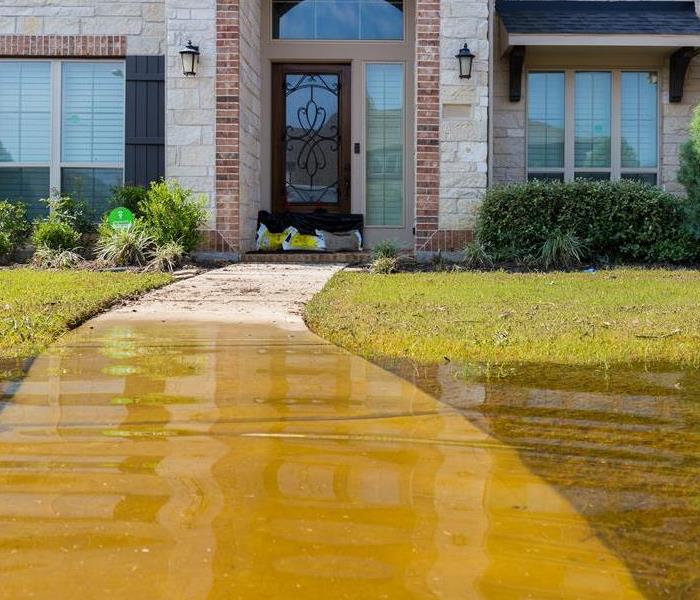 Landscaping can play a vital role in preventing flooding from your property.
Landscaping can play a vital role in preventing flooding from your property.
Landscaping not only enhances the aesthetic appeal of our properties but can also play a significant role in preventing house flooding. By strategically planning and designing our outdoor spaces, homeowners can mitigate the risk of flooding and water damage. In this blog, we will explore the importance of landscaping in flood prevention, offering valuable tips to protect your home from potential water-related disasters.
Proper Grading and Sloping
One of the most fundamental aspects of flood prevention is proper grading and sloping of the landscape. Ensuring that the land around your home slopes away from the foundation will direct water away from the house during heavy rainfall. This prevents pooling of water and reduces the likelihood of water seeping into the basement or crawl spaces. Professional landscapers can assess your property's terrain and make necessary adjustments to optimize grading and sloping for effective flood prevention.
Strategic Rainwater Diversion
Rainwater diversion techniques can significantly reduce the risk of flooding. By implementing strategies such as installing rain barrels, French drains, or dry wells, homeowners can redirect excess rainwater away from their homes. These methods help to capture and store rainwater for irrigation purposes or channel it into permeable areas of the landscape where the water can naturally soak into the ground. Proper rainwater diversion not only prevents flooding but also conserves water resources and promotes a sustainable landscape.
Well-Planned Drainage Systems
An effective drainage system is crucial for flood prevention. Incorporating features like gutters, downspouts, and catch basins can efficiently collect and redirect water away from the foundation. Connecting downspouts to underground drainage pipes or installing permeable pavers can further facilitate proper water dispersion. Regular maintenance of these drainage systems, including clearing debris and ensuring proper functioning, is essential for their effectiveness. Consulting with a professional landscaper or drainage expert can help homeowners design and implement a comprehensive drainage system tailored to their property's needs.
Strategic Plant Selection
Choosing the right plants for your landscape can contribute to flood prevention. Opt for plants that are suited to your soil type and climate, as they are more likely to establish deep root systems, enhancing soil absorption capacity during heavy rainfall. Additionally, incorporating plants that thrive in wet conditions, such as wetland plants or rain gardens, can help naturally absorb excess water. Native grasses and groundcovers are also effective in minimizing soil erosion and promoting water infiltration. Strategic plant selection, along with appropriate watering practices, can positively impact your landscape's ability to manage excess water and prevent flooding.
Landscaping plays a vital role in preventing house flooding and protecting your property from water-related disasters. By focusing on proper grading and sloping, rainwater diversion, well-planned drainage systems, and strategic plant selection, homeowners can enhance their landscape's ability to manage excess water effectively. Implementing these measures, with the guidance of landscape professionals, will help safeguard your home and create a resilient outdoor space.
Protecting Your Home: How to Prevent Water Damage While on Vacation
7/27/2023 (Permalink)
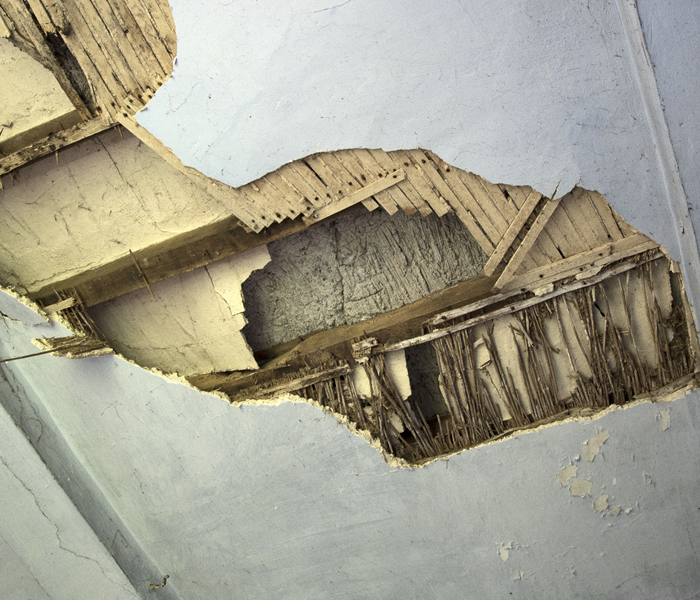 Take proactive measures to prevent water damage while on vacation.
Take proactive measures to prevent water damage while on vacation.
Going on vacation is an exciting time to relax and unwind, but it's also crucial to ensure that your home is protected while you're away. One of the significant risks during your absence is water damage, which can lead to costly repairs and extensive property damage. In this blog, we will provide you with essential tips on how to prevent water damage while you're on vacation, giving you peace of mind and a worry-free getaway.
Inspect and Maintain Your Plumbing
Before leaving for vacation, inspect your plumbing system for any leaks, drips, or signs of damage. Repair any issues you find or hire a professional plumber to address them. Ensure that all faucets, toilets, and appliances connected to water sources are in proper working condition.
Consider shutting off the main water supply to your home if you're going on an extended vacation. This step will prevent water flow to the entire property, reducing the risk of pipe bursts or leaks. Alternatively, you can shut off the water supply to specific areas prone to water damage, such as bathrooms, laundry rooms, or basements.
Insulate Pipes
Insulating exposed pipes, especially in unheated areas of your home, can help protect them from freezing and potential ruptures. Use pipe insulation sleeves or heat tape to provide a barrier against low temperatures. This step is particularly crucial during the winter months or if you live in a colder climate.
If your home has a sump pump or other water mitigation systems, ensure they are in proper working condition before you leave. Test the sump pump by pouring water into the pit to verify that it activates and pumps the water out effectively. If you have a backup power source, such as a generator or battery backup, make sure it's functional.
Clear Gutters and Downspouts
Clean out gutters and downspouts to ensure proper drainage of rainwater away from your home's foundation. Clogged gutters can cause water to overflow and seep into the walls or basement, leading to water damage. Consider installing gutter guards to minimize debris accumulation.
Invest in water leak detection devices or smart home systems that can alert you to potential leaks or abnormal water activity while you're away. These devices can detect leaks and send notifications to your smartphone, allowing you to address the issue promptly, even from a distance. Ask a reliable neighbor, friend, or family member to check on your home periodically while you're on vacation. Provide them with your contact information and instructions on how to reach you in case of an emergency. They can inspect for any signs of water damage, leaks, or unusual odors and take action if necessary.
Unplug Electronics and Appliances
To minimize the risk of electrical malfunctions and water-related accidents, unplug non-essential electronics and appliances before leaving. This precautionary measure can prevent potential water damage caused by faulty appliances or power surges.
Maintain an appropriate temperature setting in your home to prevent freezing pipes during colder months. Set the thermostat to a minimum temperature that will keep the interior warm enough to avoid pipe bursts but not excessively high to save energy.
Inform your water provider of your absence and request that they monitor your water usage for any irregularities. Some providers offer vacation services where they can shut off water to your property at the meter temporarily.
By taking proactive measures to prevent water damage while you're on vacation, you can safeguard your home and avoid potential costly repairs and property damage. Inspecting and maintaining your plumbing, shutting off the main water supply, and contacting your water company are all essential steps to protect your home while you're away. By following these tips, you can enjoy your vacation with peace of mind, knowing that your home is safe from water damage.
Will the insurance cover my broken pipe?
3/4/2023 (Permalink)
 Filing a claim after you have a broken pipe.
Filing a claim after you have a broken pipe.
Water damage is one of the most common and devastating types of property damage. Whether it’s the result of a broken pipe, a burst water heater or something else entirely, getting your insurance company involved can help you cover the cost of repairs and prevent any further damage to your home. Here are some answers to common questions about filing an insurance claim after water damage.
Insurance.
If you have a broken pipe and the water is leaking into your home, your insurance company will cover the cost of repairs. However, if your roof has a leaky spot or if there's another plumbing fixture that has sprung a leak (such as a toilet), those damages are separate claims and may not be covered by your policy. It a safe practice to know what your insurance policy covers.
In most cases where pipes break inside the walls of an older home, insurers won't deny claims because of an outdated structure, they'll just pay for the repairs needed to fix them.
Filing a claim.
After filing a claim, the insurance company will send an adjuster out to assess the damage and make a settlement offer. The adjuster is trained in assessing damage and making fair settlements for repairs. If you accept their offer, they'll pay for all necessary repairs and deduct it from your deductible (the amount of money you're responsible for). You can always decide not to accept their settlement offer and continue making repairs yourself.
Making repairs yourself.
If you have an insurance company that is offering to cover the cost of repairs, but not all of them, there are a few things to consider. First and foremost, it's important to know whether or not your policy covers broken pipes. If it does not, then there's no point in filing another claim with your insurance company because they'll just deny it again.
Secondly, if you choose not accept their offer and decide instead repair everything yourself without help from anyone else, then this means paying out-of-pocket for all those expenses as well as taking time away from work or school in order complete them and possibly losing income during those hours when most people would be working.
If these are both options seem like too much work for one person alone then maybe consider hiring someone who has experience repairing burst water lines?
You should file a claim with your insurance company whenever you have water damage. You can always decide not to accept the settlement offer and continue making repairs yourself, but this will take time and money that could be better spent on other things. If you have insurance, filing a claim is your best option
Insurance is there to protect you, so filing a claim is always a good idea. If you don't have insurance or aren't sure if your current policy covers water damage, we can help you find the right coverage for your home. Call SERVPRO today for your water restoration emergency.
5 Steps to Take After A Frozen Pipe Burst
2/13/2023 (Permalink)
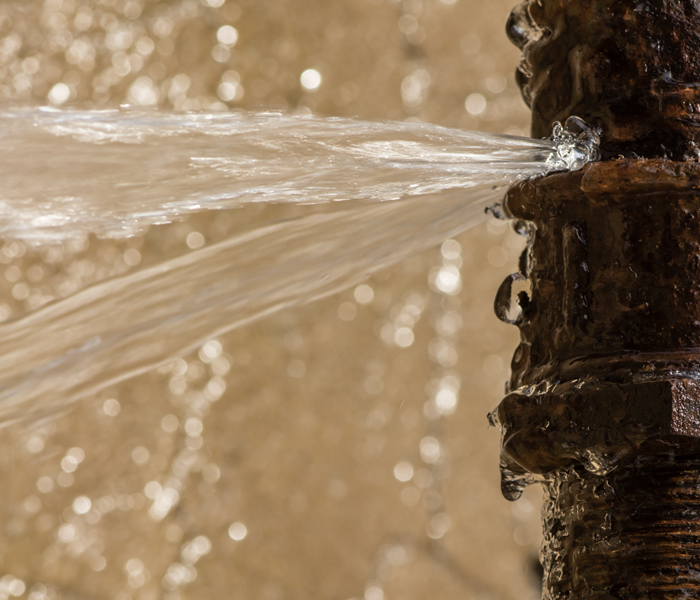 Here are five steps you can take to mitigate the damage and get things back in order.
Here are five steps you can take to mitigate the damage and get things back in order.
A frozen pipe burst can be a nightmare, but it's not the end of the world. Here are five steps you can take to mitigate the damage and get things back in order.
Turn Off the Main Water Valve
To prevent more water from spilling out into your home, it is important to turn off the main water valve. If you don't know where your home's main water valve is, call a professional for help as quickly as possible.
Turn off each individual faucet and drain in your house, as well as any appliances that rely on water—like dishwashers and washing machines. You may also want to consider turning off or unplugging anything that relies on electricity, like televisions and lamps.
Remove the Water
If the leak isn't too severe, try to remove the water from your home. Removing any moisture can prevent secondary damage from occurring on your property. However, in many cases with frozen pipe bursts, the amount of water present is too much for the average person to remove without the proper equipment. In these cases, it is best to call a professional water mitigation expert as quickly as possible.
Waiting to call a professional can result in further damage to your property, so make sure you call someone as soon as you notice the pipe burst has occurred.
Document the Damage
The next thing you should do is get your camera out and take as many photos of the damage as possible. This will be helpful when it comes time to file a claim with your insurance company because it'll give them an idea of how much money they'll have to pay out on your behalf.
You'll want to take pictures of anything that was damaged by the burst pipe—including walls, furniture, personal items like clothing and electronics, and even small things like photographs or decorations on shelves that may have gotten wet.
It is also important to take photos of the cleanup process. These pictures will serve as evidence if there are any disputes.
When working with a mitigation and restoration company such as SERVPRO of Northwest San Antonio, they will take care of all of this for you and will extensively document everything from start to finish.
Call Your Insurance Company
As soon as possible after a pipe burst, contact your insurance agent to file a claim and start the claims process. The insurance company will want to know the extent of the damage and any other information that may be helpful in processing your claim.
Call a Disaster Cleaning and Restoration Company
The most important thing you should do after a frozen pipe burst is to call our SERVPRO of Northwest San Antonio team for help. Our team is the leading provider of restoration services in the San Antonio area, so you can be sure that we will take care of your property and get it back to normal as quickly as possible. Our team will come in and assess the damage, determine what needs to be cleaned up, and take care of all mitigation and restoration-related tasks for you.
We hope this blog post has given you the information that you need to deal with a frozen pipe burst. If you have any questions, don't hesitate to contact our team of experts today!
Dealing with Water Damage in Your Attic
12/22/2022 (Permalink)
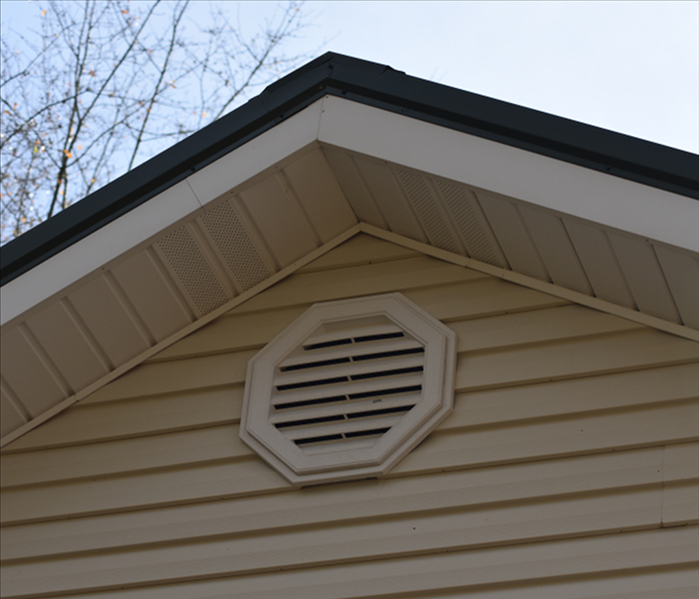 Water damage in your attic is a serious problem that can cause mold and rot, which will lead to structural problems down the road.
Water damage in your attic is a serious problem that can cause mold and rot, which will lead to structural problems down the road.
Dealing with Water Damage in Your Attic
Water damage in your attic is a serious problem that can cause mold and rot, which will lead to structural problems down the road. If you're worried about water damage in your attic, here's what you need to know about how to prevent it from happening.
Finding the Leak and Damage
If you have a leak in your San Antonio, TX home, it's important to find the source of the water damage and take steps to correct it. If you are unable to identify where the water is coming from, or if you don't know how to fix it, reach out for help.
If there is mold growth around the problem area, clean up any visible mold with an all-purpose cleaner. Use a stiff brush and scrubbing pad (not just disposable wipes) so that you can get into corners and along edges thoroughly; this will ensure that all surfaces are treated equally and no hidden spots remain untreated.
Common Causes of Attic Water Damage
Water damage in your attic can be caused by a variety of sources. These include:
- A leaking roof
- A leaking plumbing system
- A leaking air conditioning system
- Leaking appliances (including dishwashers, washing machines, and hot water heaters)
- Water seeping into your home through windows or skylights
Signs of Water Damage in the Attic
There are some signs that could indicate issues in your attic:
- If you see any water stains on your ceilings or walls, this could be an indication that there is some kind of moisture problem in your attic.
- Another sign that you have a water damage issue is if there are obvious signs of mold growth, such as black spots or patches. Mold spores can easily get into your home through an opening in the roof and stay there until they grow into something bigger and more problematic—and even then, they might still be hiding out in other areas of your house! This means that you should take action immediately when you notice any signs of mold growth because it's best to remove these spores before they spread throughout your home and cause more damage than necessary!
- A musty smell in a room or on your clothes can indicate mold growth. This indicates that bacteria has slowly grown over time due to high humidity levels allowed by leaky pipes under sink cabinets,
How to Prevent Water Damage in Your Attic
Prevent damage to your roof, foundation, and walls. As you've read above, water that leaks into your attic can cause damage to the insulation and to items stored up there. To prevent this from happening, it is important that you repair any roof leaks as soon as possible. If you are not sure what type of repairs should be made, contact a professional like SERVPRO of Northwest San Antonio.
Keep gutters clean and free of debris. If your gutters are clogged with leaves or other debris, then rainwater will have trouble flowing down them toward the ground where it belongs; instead, it flows onto the surface of your home's exterior wall or worse yet gets trapped in your attic.
Make sure you clean out your rain gutters regularly. If left unattended over time this will lead to water pooling around chimneys which could cause costly damage when frozen during winter months causing cracked mortar joints between bricks which could result in expensive repairs later on down the road so better safe than sorry!! We suggest checking them every month during springtime just before warmer weather arrives so no surprises happen later on down south.
How to Fix Water Damage in Your Attic
Once you've determined that your attic has suffered water damage, it's time to get started cleaning up. The first step is to remove any wet insulation and drywall from your attic floor. This will allow the space to dry out completely, which should not be done without taking these precautions. Next, remove wet insulation from joists or rafters in the ceiling. If you have a leaky roof, take care of that as soon as possible by repairing or replacing damaged shingles and decking materials.
Act Quickly
If you have a leak in your roof or attic, it needs to be found and fixed as soon as possible. Water damage can lead to mold growth, structural damage, electrical problems, and property damage. It’s important to get help from professionals if you are not sure how to fix the issue.
It’s important to remember that water damage in your San Antonio attic can lead to serious problems for you, your family and pets. The longer it goes unrepaired, the more damage will occur and the more expensive it will be to fix. If you have any concerns about the condition of your home’s roof or attic, contact us today for mold remediation and water damage restoration in your home.
Saving a Flooded Basement
11/4/2022 (Permalink)
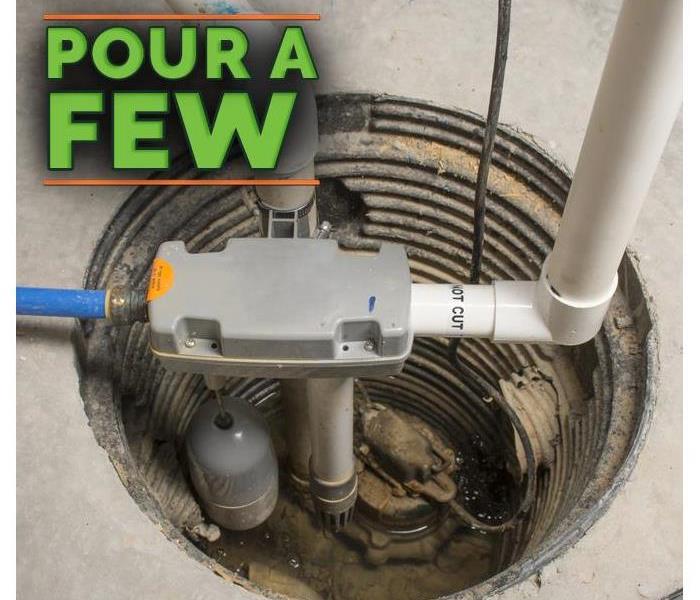 Using a sump pump can help prevent water damage in your facility.
Using a sump pump can help prevent water damage in your facility.
Saving a Flooded Basement
If your basement has been flooded, you need to act quickly. Water can cause mold and mildew to grow, which will make your San Antonio, TX home uninhabitable. If your basement has flooded, the first step is to stop the water from entering. If you haven't already done so, shut off your main water valve and turn off any individual faucets that may be letting in water.
Next comes removing as much of the water from your basement as possible. There are two ways to do this: you can use a sump pump or hire professionals who specialize in draining flooded basements.
Sump pumps are usually installed after a basement waterproofing job or new construction so that they can help remove any excess moisture from beneath floors and walls before it causes serious damage to these structures (and potentially damage to other parts of your home). They're also used when flooding occurs outside an already-installed drainage system—for example, when heavy rains come through during springtime thaw periods—or if there's been some sort of accident involving broken pipes inside homes without proper drainage systems installed beforehand.
If you choose this method for removing excess water from below ground level then make sure all drains are clear before starting up again!
What kind of pump is best to remove water from the basement?
When evaluating the type of pump you need to remove water from your basement, it's important to know a few key performance characteristics.
First, there's the size of the pump; different models come in different sizes and can move more or less water. Next, there's how much power it takes to operate the pump—a bigger motor means more power, which translates into faster evacuation times. Finally, there are some pumps that are specifically designed for use with sump pits and other low-lying areas where an ordinary submersible model may not be effective at extracting water from underneath the surface of your home's foundation.
To make sure you get exactly what you need from our selection of pumps, here are some specs that may help guide your decision:
- Gallons per minute (gpm) refers to how much liquid a particular model can pump per minute through its rotating impeller blades at maximum capacity (or "flow rating").
- Horsepower (hp) refers to how much energy is required by each unit over time while operating under optimal conditions (i.e., fresh batteries).
Drying Out the Basement
To dry out a flooded basement, you will need to use fans, dehumidifiers, and wet/dry vacuums.
Fans
Fans help in drying up water in basements by circulating air around it. The best way to use fans for this purpose is by installing them in one corner of your basement, so they can suck up all the dampness from other corners as well.
Dehumidifiers
Use a dehumidifier to remove excess moisture. Not only do they help remove excess moisture but also help reduce mold growth. Mold growth is common after a water damage event, so try to prevent it as much as possible.
You should always purchase high-quality equipment though because some cheaper ones tend to break down very quickly when used continuously over a long period of time.
How Long Does It Take to Dry Out a Basement?
The amount of time it takes for a flooded basement to dry out depends on several factors. First, the size of the basement will affect how quickly water evaporates. If there's a lot of space in your basement but not much water, it will take less time than if your basement is small and filled with standing water.
Second, how well you can ventilate your flooded basement and how well you're able to dry it out will also affect drying times.
Third, if your floors are wood or concrete and don't absorb moisture easily then this will play into how long it takes for them to dry out after being exposed for several days or weeks (if ever).
Pumping water out of the basement is one way to mitigate flood damage.
Drainage pumps are another popular option for removing water from your flooded basement. These devices come in a variety of sizes, ranging from small-scale pumps that can be operated by one person to large-scale systems that require two people and higher amounts of electricity. They're incredibly easy to install and operate—just plug the pump into an outlet, connect it to your sump pump (or other drainage sources), then turn on the device and wait for the water to be removed from your home.
A similar product is called an electric submersible pump, which is specifically designed for use in flood-prone areas or homes with high groundwater levels. These are also fairly simple to operate: just place them inside your sump hole and turn on the power switch!
If you have a flooded basement and you need to pump water out, there are several options. The best solution is to call SERVPRO of Northwest San Antonio to take care of it for you. Give us a call!
3 Ways To Maintain Your Rental Home's Pipes
8/21/2022 (Permalink)
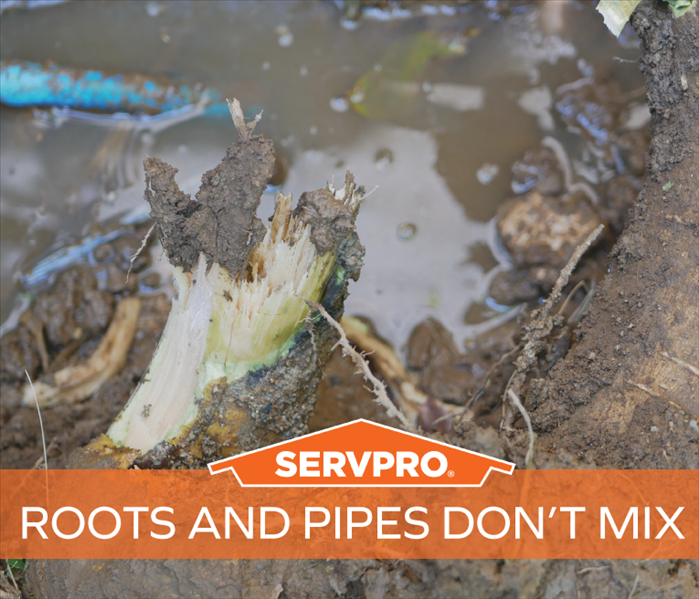 Take care of tree roots.
Take care of tree roots.
3 Ways to Keep Your Rental Home's Pipes in Good Condition
If you have an older rental home in San Antonio, TX, remember that regular pipe maintenance prevents plumbing issues and potential damage. Follow the tips below to keep your rental home in peak condition and save yourself the headache of cleaning up from leaking or busted pipes.
Why Maintenance Is Important For Your Rental
Problems with pipes often come from clogs or faulty piping. Over time, sludge, hair and whatever gets flushed down a toilet or drain can build up in your pipes, clogging the system. While you can quickly clear sink clogs with a treatment, mainline clogs can lead to leaking and damage.In older homes, polybutylene pipes can become brittle and, without proper maintenance, can break. These pipes made from a plastic resin can sometimes react with oxidants found in public water, resulting in micro-fractures and an overall weakening of your system.
How To Maintain Your Pipes
Use an enzyme treatment: Pour an enzyme mixture down your drains and into your toilet regularly, starting once a week and gradually moving to once a month. Let the mix sit in your pipes overnight, flushing it out with hot water in the morning. You can also find a mainline enzyme mix to clean out your entire piping system four times a year.
Be aware of what you put down your drain: Ask your tenants to be wary of what they put down the sinks. Do not put hair down a bathroom sink or certain food scraps down a kitchen sink, even if it has a garbage disposal.
Take care of tree roots: Tree roots can grow into your home’s pipes, so ensure that you’re plumbing system is not affected by a wandering limb. You can flush a root-killing treatment down your toilet twice a year to kill off any stray roots without harming the tree.
Regular pipe maintenance is essential for keeping older homes free from damage. Use treatments and caution to prevent your home from needing professional services for water damage or plumbing issues. Have peace of mind knowing your rental home is safe.
Commercial Irrigation System Troubleshooting Tips
7/18/2022 (Permalink)
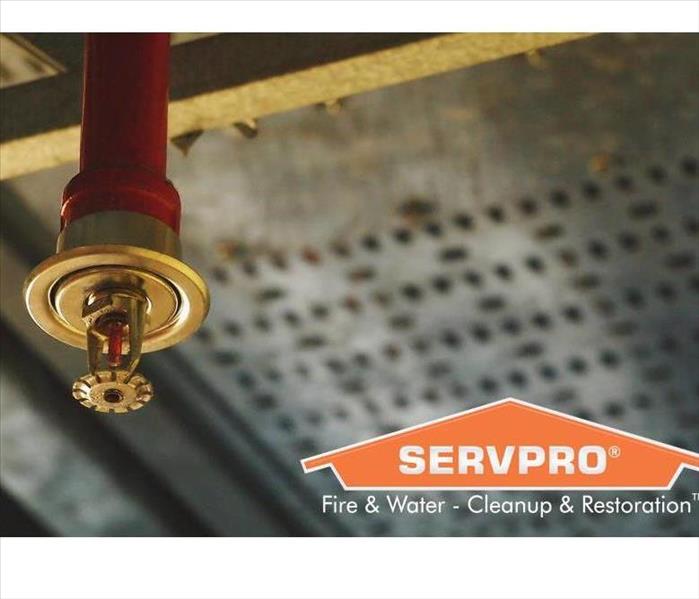 It is best practice to examine your sprinkler system periodically to avoid future irrigation problems.
It is best practice to examine your sprinkler system periodically to avoid future irrigation problems.
Troubleshooting Commercial Irrigation Systems
A working sprinkler system can produce a lush, green landscape for a San Antonio, TX, business. However, if it malfunctions, it could cause flooding. If the ground is too saturated, especially near any buildings, you could wind up with water soaking through cracks in the foundation and entering your basement or concrete slab. If this scenario occurs, you should call in a water damage cleanup team. Before that situation happens, try locating and repairing the leak yourself. Here are some simple ways you can troubleshoot.
Examine Irrigation System
The first thing you will want to do is walk around the area where you have sprinklers.
- Stop at each sprinkler head. Inspect to make sure none are broken or missing.
- Look for water that is not where it should be or is pooled up. Pay particular attention to any water that is near a building.
- Listen for the sound of running water. If you have a leak or a broken pipe, you should be able to hear it.
- As you are inspecting your irrigation system, place markers at each location where you have found a problem so you can return to it quickly when you go back to fix it.
Repair and Replace
Once you have finished your walkthrough, return to the flagged areas and start your repairs. Clean out dirt and debris from clogged sprinkler heads. Replace any rubber seals or gaskets that were leaking during your inspection. Repair or replace any broken or missing sprinklers.
Perform Maintenance Checks
It is best practice to examine your sprinkler system periodically to avoid future irrigation problems. Doing a thorough check of your irrigation system when you start using it each year will help identify any repairs needed before bigger problems occur.
Investing time to troubleshoot and repair any problems at your business yourself will save time and money and provide a beautiful landscape for your customers and San Antonio, TX, residents for years to come.
How to Care for Damage Belongings After a Flood
6/9/2022 (Permalink)
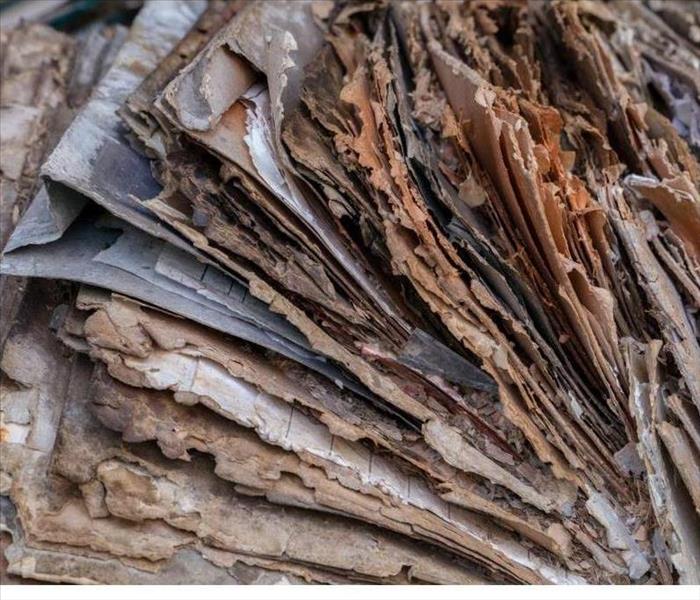 If you have wet documents caused by a broken pipe or flooding let a professional take care of it.
If you have wet documents caused by a broken pipe or flooding let a professional take care of it.
How to Handle Flood-Damaged Personal Property
You may not sit around thinking much about what would happen in the workplace if there was flooding. However, a flooded company could cause widespread damage and have a disastrous effect on your business. Along with damage to your San Antonio, TX, building, you may have severe damage to contents such as documents, furniture, and electronics. Fortunately, there are ways to salvage and restore these items.
1. Cleaning Carpets
A flooded company will likely mean that any carpet you have in the building will have extensive water damage. This can make the environment unhealthy. In some cases, you may not be able to save the carpet. But a professional flood restoration company has the equipment and techniques to clean up after many flooding incidents. Technicians will rip out the carpet and then replace the padding underneath. Using industrial-strength machines, technicians will then extract the water. Lastly, the technicians will sanitize the carpet before replacing it.
2. Dry Cleaning Furniture
Content cleaning will also apply when there is wet furniture. Using a similar process, technicians will thoroughly remove any water from water-damaged furniture. Sanitizing the surfaces will be critical too. The process will also include completely drying the furniture. This will discourage mold growth.
3. Cleaning Electronics
If you have wet computers, printers, or other electronics, don't touch them or turn them on. Let a professional handle this cleaning task. A technician will assess the extent of the damage. Often, the technician will have to disassemble the computer and clean the motherboard. This task requires a delicate and careful approach.
4. Cleaning Documents
Whether from a broken pipe or other cause, flooding can inflict a lot of damage on documents. These include files, books, maps, and other important paperwork. Freeze-drying is often the most effective technique for salvaging and restoring wet documents.
If you have a flooded company, you may experience a lot of water damage. Thankfully, professionals can clean many of the ruined items.
3 Bad Things That Happen When There’s Moisture in Your Crawl Space
4/8/2022 (Permalink)
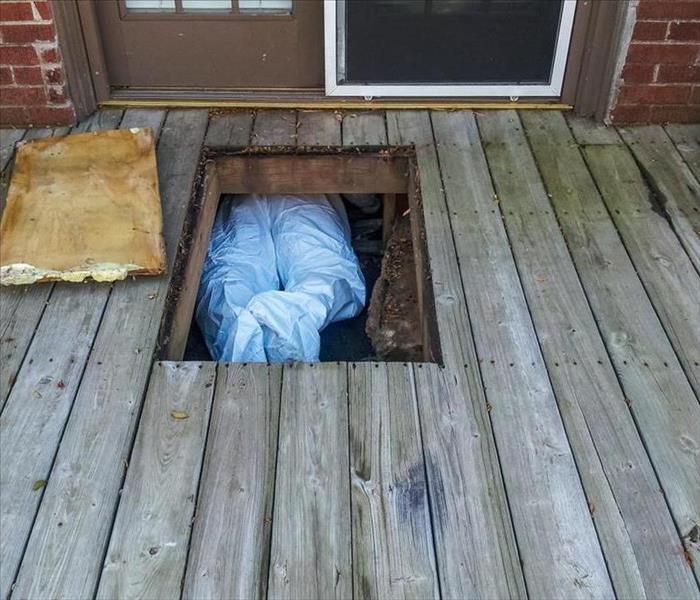 A wet crawl space is a perfect location for mold to grow and start consuming organic materials.
A wet crawl space is a perfect location for mold to grow and start consuming organic materials.
3 Things That Go Wrong When You Have Moisture In Your Crawl Space
When there is a flood in your crawl space, the problem and the damage are clear. However, less obvious moisture can also lead to a wet crawl space and cause problems that you might not expect.
1. Higher Energy Bills
Houses with damp crawl spaces cost more to heat and cool. This is because damp air requires more energy to change the temperature, leading to higher energy bills. In other words, moisture in your crawl space can be an expensive inconvenience.
2. Mold
Mold loves to grow where it can find moisture. As it grows, it eats organic materials, such as wood, paper, and cardboard. Unfortunately, a wet crawl space is a perfect location for mold to grow and start consuming organic materials. Dead insects that crawled in through your vent are also a great source of food for mold. These carcasses encourage mold growth if there is just a little bit of moisture in your basement.
Moisture can seep in through vents or cracks in your foundation. Even the smallest amount can encourage mold to grow and spores to start drifting through the rest of your home. This is a problem that you need to have remedied by a water restoration company quickly. Otherwise, you could be faced with a structurally unsound home that is dangerous to live in.
3. Pests
Dust mites and other pests love a wet environment that your flooding crawl space can provide. Dust mites are microscopic bugs that infest your bedding, carpets, and furniture if left untreated. Additionally, you could end up with termites, spiders, mice, rats, and snakes, all of which love damp areas. Once they enter your crawl space, any of these animals can get into your home.
If you notice that you have a wet crawl space in your home in San Antonio, TX, you should be on the lookout for the associated problems. While some are inconvenient, others can be dangerous or disgusting.
How You Can Prepare for a Home Adjuster's Visit
4/1/2022 (Permalink)
 Contact a water damage remediation service in San Antonio, TX, to begin drying everything out and keep further damage at bay.
Contact a water damage remediation service in San Antonio, TX, to begin drying everything out and keep further damage at bay.
How To Prepare For A Visit From A Home Adjuster
If you've just sustained water damage to your property, make sure to call your insurance company right away so you can begin the claims process as soon as possible. Soon after the initial call, they'll send out a home adjuster to assess the damage and file a report. Though he or she will be the one to make the official report, there are things you can do that will help move the process along faster. Here's how you can prepare ahead of time to make that happen.
Document the Damage
You know your home better than anyone, so you are not likely to miss anything that's been damaged, no matter how small. Take a detailed inventory of what's been damaged and lost — in writing, in photos and on video, if possible. You can ask the adjuster to include them in the report alongside his or her findings.
Clear a Path
Clear the way for the home adjuster to move freely around your property, so nothing will be missed. If you have to move the debris to do that, make sure you don't remove it entirely. The insurance claim needs as much evidence as possible included so that you receive the proper coverage and reimbursement.
Prevent Further Damage
Contact a water damage remediation service in San Antonio, TX, to begin drying everything out and keep further damage at bay. The team will also help you itemize and categorize the damages and losses you incurred.
Know Your Policy
Before the adjuster arrives, review your policy with your agent. You should know what is and isn't covered, the limits of your policy and when to expect reimbursement so you can start making arrangements for repairs and replacements.
When the worst happens and your home sustains serious water damage, it's nice to know you have qualified professionals in your corner. Your insurance company and the home adjuster will work with you to make sure you get the help you need and get back on your feet as soon as possible.
How To Clean Up a Water Heater Leak
1/24/2022 (Permalink)
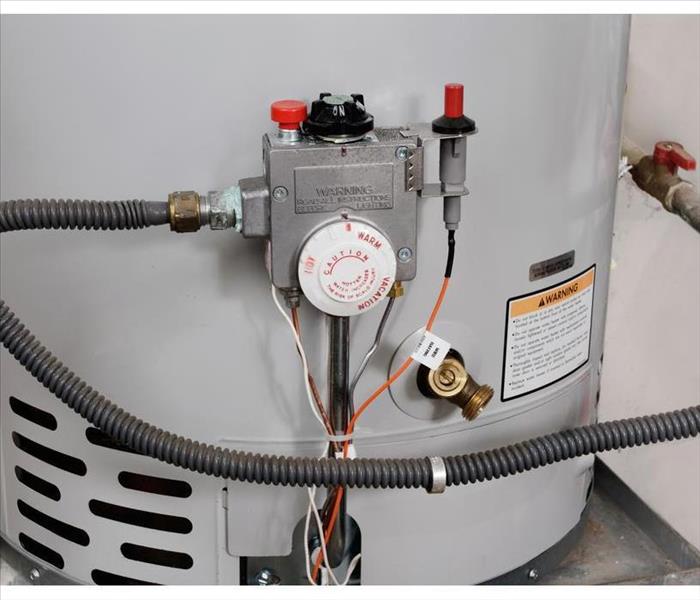 A leaking water heater can cause damage to your home.
A leaking water heater can cause damage to your home.
How To Cleanup After Water Damage
A leaking water heater can cause significant problems at a residence in San Antonio, TX. Here are the measures necessary to mitigate water damage.
Identify the Source
There are several reasons a water heater may leak. A quick inspection of the exterior may indicate one of the following issues:
- Corroded water tank
- Faulty drain valve
- Faulty temperature and pressure relief valve
- Leaky inlet and outlet connections
Even if you cannot identify the cause of a broken water heater, try to determine the source of the leak. Condensation may resemble a leak.
Turn Off the Power
Shut off a leaking water heater at the circuit breaker box or by turning off the gas dial or switch. Turn off the cold water shut-off valve located above or near the heater or the main water valve to your home. These measures can slow down a leak.
Drain the Tank
After the power and water are off, you can drain the tank to attempt a repair. There are several steps to remove water from a heater:
- Run hot water in a sink or tub
- Wait for remaining water in tank to cool
- Open the pressure relief valve
- Run a hose from the drainage spigot to a bucket
- Turn on the spigot
These steps can enable you to replace valves safely. If you do not want to drain the tank or attempt repairs yourself, contact a repair specialist or licensed plumber to work on a failed water heater.
Dry the Area
Limit water damage and the risk of mold growth by removing soaked carpets. Dry the floor and any walls exposed to the water. You may want to run a dehumidifier or use a desiccant such as silica gel. Ventilation will promote faster drying.
If a leak is extensive, contact water damage cleanup experts in San Antonio, TX. Specialists can use commercial-grade equipment to extract standing water and recommend the best approach for dealing with materials soaked by a leaking water heater.






 24/7 Emergency Service
24/7 Emergency Service













